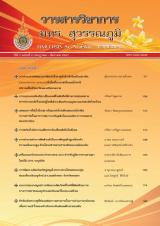การจำแนกชนิดของปรสิตปลิงใสกลุ่มโมโนจีเนียนในปลานิล (Oreochromis niloticus) ที่เลี้ยงในกระชังในแม่น้ำปี บริเวณพื้นที่ จังหวัดนครศรีธรรมราช
Main Article Content
Abstract
การศึกษาชนิดของปรสิตปลิงใสโมโนจีเนียนในปลานิล (Oreochromis niloticus) ที่เลี้ยงในกระชังบริเวณพื้นที่แม่น้ำตาปี อำเภอฉวาง จังหวัดนครศรีธรรมราช โดยใช้เวลาการศึกษา 1 รอบการเลี้ยง (120 วัน) ทำการเก็บตัวอย่าง ในระหว่างวันที่ 14 มิถุนายน - 31 ตุลาคม พ.ศ. 2556 รวม 8 ครั้ง โดยเก็บตัวอย่างปลานิลครั้งละ 10 ตัว รวมทั้งหมด 80 ตัว พบปรสิตปลิงใสโมโนจีเนียนทั้งที่อยู่บริเวณเหงือก และผิวหนังของปลานิล พบปรสิตทั้งหมด 480 ตัว โดยปรสิตที่ตรวจพบบริเวณเหงือกมีทั้งหมด 2 สกุล (Genus) คือสกุล Cichlidogyrus ซึ่งพบจำนวน 3 ชนิด (Species) คือ Cichlidogyrus sclerosus (60 ตัวอย่าง), Cichlidogyrus tilapiae(100 ตัวอย่าง), Cichlidogyrus halli (230 ตัวอย่าง)และอีก 1 สกุลที่พบคือ Scutogyrus พบจำนวน 1 ชนิด คือ Scutogyrus longicornis (70 ตัวอย่าง) และปรสิตที่ตรวจพบบริเวณผิวหนัง จำนวน 1 สกุล คือ Gyrodactylus spp. (20 ตัวอย่าง) โดยมีค่าความชุก ดังนี้ C. halli (32.86 %), C. tilapiae (12.86 %), C. sclerosus (8.57 %), S. longicornis (10.00%) และ Gyrodactylus spp. (2.86 %) ส่วนความหนาแน่น พบว่า C. halli มีค่ามากที่สุด เท่ากับ 0.33, C. tilapiae เท่ากับ 0.13, S. longicornis เท่ากับ 0.10, C. sclerosus เท่ากับ 0.09 และน้อยที่สุด คือ Gyrodactylus spp. เท่ากับ 0.03
Identification on Monogenean Parasite in Nile Tilapia, Oreochromis niloticus from Cage Culture in Thapi river, Nakorn Si Thammarat Province
This study purposed to investigate the Nile Tilapia’s Monogenean parasites from cage culture in Thapi Riiver, Nakorn Sri Thammarat province, South of Thailand. The data were collected during 1 cultivation cycle (June, 14th-31st October, 2012). The sample groups were collected through 8 times from 80 fish (10 fish/ each). There were 480 monogenean parasites from the gills, the genus and the skin. The Monogenean parasites from the grill included 2 genera which detected into 3 species – Cichlidogyrus sclerosus (60), Cichlidogyrus tilapiae(100), and Cichlidogyrus halli (230). Moreover, there was another genus, Scutogyrus which known as the Scutogyrus longicornis (70). Besides that, there was a genus from the skin called Gyrodactylus spp. (20) which showed the percentage of the prevalence of the C. halli (32.86 %), the C. tilapiae (12.86 %), the S. longicornis (10.00 %), the C. sclerosus (8.57%), and the Gyrodactylus spp. (2.86 %). The density of the Nile Tilapia’s Monogenean parasite, showed that C. halli was the highest = 0.33, the C. tilapiae = 0.13, the S. longicornis = 0.10, the C. sclerosus = 0.09 and the Gyrodactylus spp. = 0.03.
Article Details
Published manuscript are the rights of their original owners and RMUTSB Academic Journal. The manuscript content belongs to the authors' idea, it is not the opinion of the journal's committee and not the responsibility of Rajamangala University of Technology Suvarnabhumi


